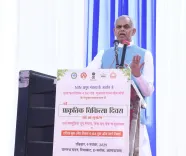Is GST 2.0 a Game Changer for India’s Artisans?

Synopsis
Key Takeaways
- GST 2.0 reduces tax from 12% to 5% on handicrafts.
- Higher demand leads to better earnings for artisans.
- Competitive pricing enhances market position against factory goods.
- Supports traditional crafts across various Indian states.
- Boosts exports by attracting niche luxury buyers.
New Delhi, Nov 9 (NationPress) The recently introduced GST 2.0 has significantly reduced the tax rate on numerous handicraft items from 12 percent to 5 percent, providing a substantial advantage to India's artisans. This change has sparked an increase in demand for their products, resulting in enhanced earnings and improved competitiveness against mass-produced items.
Artisans involved in creating wooden carvings, terracotta jute bags, textiles, and leather goods are among those reaping the benefits of this tax cut.
The muga silk industry in Assam, predominantly found in regions like Sualkuchi (Kamrup), Lakhimpur, Dhemaji, and Jorhat, is a cherished legacy upheld by women weavers. The lowered GST rate on handloom and handicraft items will be a relief to these artisans, allowing them to engage in competitive markets and improve their profit margins. It is also expected to enhance exports, drawing the interest of niche luxury consumers who may be more willing to purchase when prices are slightly reduced.
The entire handloom sector in Assam stands to benefit from these GST adjustments. In a state boasting over 12.83 lakh weavers and around 12.46 lakh looms, the implications are profound.
The tax reduction will also impact traditional crafts such as Assam Jaapi, Asharikandi terracotta, Mishing handloom, Pani Meteka, and Bihu dhol.
By easing the tax burden, these reforms are poised to create stronger markets for traditional handicrafts and handlooms, potentially increasing income for artisans and ensuring that handmade Assamese textiles remain competitive in the face of factory-produced alternatives.
West Bengal has a rich history of traditional crafts and handlooms, from the terracotta temples of Bishnupur to the detailed Nakshi Kantha embroidery. The reduction in GST from 12 percent to 5 percent directly benefits this sector by lowering prices and boosting its competitiveness against machine-produced or mass-manufactured imitations in both domestic and international markets, including Europe, the US, and Japan.
With the GST decrease from 12 percent to 5 percent, eco-friendly jute products, such as bags, are now more competitive compared to plastic or synthetic options. This shift encourages domestic consumption in urban areas while also aiding exports. West Bengal, which is the heart of India's jute industry, provides direct employment to over 2.5 lakh workers in organized mills and supports around 40 lakh farming families.
Items like Madurkathi Mats, Purulia Chhau Masks, and Wooden Masks from Kushmandi and Sholapith Craft are other handicrafts poised to benefit from the GST rate reductions.
The famous handloom products from Himachal Pradesh, particularly its shawls and woolen textiles, are also set to gain from the GST cut from 12 percent to 5 percent. In the Kullu valley, over 3,000 weavers in self-help groups create the vibrant, GI-tagged Kullu shawls. These artisans are part of a larger community of an estimated 10,000-12,000 handloom artisans statewide. Shawl makers in the Kinnaur district and others engaged in these crafts will also see benefits.
The Chamba rumal, a GI-tagged, intricately hand-embroidered cloth made primarily by women in the Chamba district of Himachal Pradesh, is expected to witness increased demand due to the GST reduction to 5 percent. Traditional leather slippers from Chamba, another GI-tagged product produced by numerous small cottage industries, will also become more competitively priced against machine-made footwear, promoting sales of these indigenous chappals and improving artisans' margins.
From intricately carved wooden doors and panels to furniture, the carved wooden products crafted in areas like Chamba, Kinnaur, and Kullu employ thousands of rural artisans in Himachal. The new GST rates classify wooden articles under the 5 percent category, which is expected to increase demand for locally made wooden furniture and souvenirs. This will not only make these items more affordable but also support local craftsmen. Additionally, regions in Himachal that produce bamboo products, such as baskets and other eco-friendly crafts, will also see gains.









